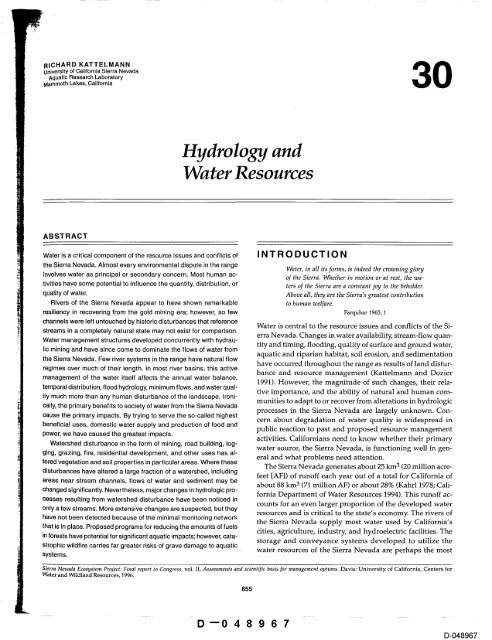D--048966 - CALFED Bay-Delta Program - State of California
D--048966 - CALFED Bay-Delta Program - State of California
D--048966 - CALFED Bay-Delta Program - State of California
You also want an ePaper? Increase the reach of your titles
YUMPU automatically turns print PDFs into web optimized ePapers that Google loves.
RICHARD KATTELMANN<br />
University <strong>of</strong> <strong>California</strong> Sierra Nevada<br />
Aquatic Research Laboratory<br />
Mammoth Lakes, <strong>California</strong><br />
ABSTRACT<br />
Hydrology and<br />
Water Resources<br />
Water is a critical component <strong>of</strong> the resource issues and conflicts <strong>of</strong> I N T R O D U C T I O N<br />
the Sierra Nevada. Almost every environmental dispute in the range<br />
involves water as principal or secondary concern. Most human activities<br />
have some potential to influence the quantity, distribution, or<br />
Water, in all its forms, is indeed the crowning glory<br />
<strong>of</strong> the Sierra. Whether in motion or at rest, the wa-<br />
ters <strong>of</strong> the Sierra are a constant joy to the beholder.<br />
quality <strong>of</strong> water. Above all, they are the Sierra’s greatest contribution<br />
Rivers <strong>of</strong> the Sierra Nevada appear to have shown remarkable to human welfare.<br />
resiliency in recovering from the gold mining era; however, so few Farquhar 1965, 1<br />
channels were left untouched by historic disturbances that reference<br />
streams in a completely natural state may not exist for comparison,<br />
Water management structures developed concurrently with hydrau-<br />
lic mining and have since come to dominate the flows <strong>of</strong> water from<br />
the Sierra Nevada. Few river systems in the range have natural flow<br />
regimes over much <strong>of</strong> their length. In most river basins, this active<br />
management <strong>of</strong> the water itself affects the annual water balance,<br />
temporal distribution, flood hydrology, minimum flows, and water quality<br />
much more than any human disturbance <strong>of</strong> the landscape. Ironi-<br />
cally, the primary benefits to society <strong>of</strong> water from the Sierra Nevada<br />
cause the primary impacts. By trying to serve the so-called highest<br />
beneficial uses, domestic water supply and production <strong>of</strong> food and<br />
power, we have caused the greatest impacts,<br />
Watershed disturbance in the form <strong>of</strong> mining, road building, logging,<br />
grazing, fire, residential development, and other uses has altered<br />
vegetation and soil properties in particular areas. Where these<br />
Water is central to the resource issues and conflicts <strong>of</strong> the Si-<br />
erra Nevada. Changes in water availability, stream-flow quantity<br />
and timing, flooding, quality <strong>of</strong> surface and ground water,<br />
aquatic and riparian habitat, soil erosion, and sedimentation<br />
have occurred throughout the range as results <strong>of</strong> land distur-<br />
bance and resource management (Kattelmann and Dozier<br />
1991). However, the magnitude <strong>of</strong> such changes, their relative<br />
importance, and the ability <strong>of</strong> natural and human communities<br />
to adapt to or recover from alterations in hydrologic<br />
processes in the Sierra Nevada are largely unknown. Con-<br />
cern about degradation <strong>of</strong> water quality is widespread in<br />
public reaction to past and proposed resource management<br />
activities. <strong>California</strong>ns need to know whether their primary<br />
water source, the Sierra Nevada, is functioning well in gen-<br />
eral and what problems need attention.<br />
The Sierra Nevada generates about 25 km3 disturbances have altered a large fraction <strong>of</strong> a watershed, including<br />
areas near stream channels, flows <strong>of</strong> water and sediment may be<br />
(20 million acre-<br />
feet [AF]) <strong>of</strong> run<strong>of</strong>f each year out <strong>of</strong> a total for <strong>California</strong> <strong>of</strong><br />
about 88 km3 changed significantly. Nevertheless, major changes in hydrologic processes<br />
resulting from watershed disturbance have been noticed in<br />
only a few streams. More extensive changes are suspected, but they<br />
have not been detected because <strong>of</strong> the minimal monitoring network<br />
that is in place. Prol~osed programs for reducing the amounts <strong>of</strong> fuels<br />
in forests have potential for significant aquatic impacts; however, catastrophic<br />
wildfire carries far greater risks <strong>of</strong> grave damage to aquatic<br />
systems.<br />
(71 mLllion AF) or about 28% (Kahrl 1978; Callfornia<br />
Department <strong>of</strong> Water Resources 1994). This run<strong>of</strong>f ac-<br />
counts for an even larger proportion <strong>of</strong> the developed water<br />
resources and is critical to the state’s economy. The rivers <strong>of</strong><br />
the Sierra Nevada supply most water used by <strong>California</strong>’s<br />
cities, agriculture, industry, and hydroelectric facilities. The<br />
storage and conveyance systems developed to utilize the<br />
water resources <strong>of</strong> the Sierra Nevada are perhaps the most<br />
Sierra Nevada Ecosyste~n Project: Final report to Congress, vol. I[, Assessments and scientific basis for management options. Davis: University <strong>of</strong> <strong>California</strong>, Centers for<br />
Water and Wildland Resources, 1996.<br />
855<br />
D--048967<br />
30<br />
D-048967

















